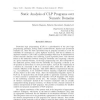Free Online Productivity Tools
i2Speak
i2Symbol
i2OCR
iTex2Img
iWeb2Print
iWeb2Shot
i2Type
iPdf2Split
iPdf2Merge
i2Bopomofo
i2Arabic
i2Style
i2Image
i2PDF
iLatex2Rtf
Sci2ools
103
click to vote
SAS
1992
Springer
1992
Springer
Static Analysis of CLP Programs over Numeric Domains
Abstract Constraint logic programming (CLP) is a generalization of the pure logic programming paradigm, having similar model-theoretic, fixpoint and operational semantics [9]. Since the basic operational step in program execution is a test for solvability of constraints in a given algebraic structure, CLP has in addition an algebraic semantics. CLP is then a general paradigm which may be instantiated on various semantic domains, thus achieving a good expressive power. One relevant feature is the distinction between testing for solvability and computing a solution of a given constraint formula. In the logic programming case, this corresponds to the unification process, which tests for solvability by computing a solution (a set of equations in solved form or most general unifier). In CLP, the computation of a solution of a constraint is left to a constraint solver, which does not affect the semantic definition of the language. This allows different computational domains, e.g. real arithm...
| Added | 10 Aug 2010 |
| Updated | 10 Aug 2010 |
| Type | Conference |
| Year | 1992 |
| Where | SAS |
| Authors | Roberto Bagnara, Roberto Giacobazzi, Giorgio Levi |
Comments (0)

